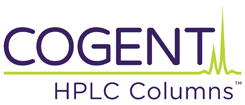Phosphorylated compounds can be difficult to analyze with HPLC.
However, a wide variety of compounds with the phosphate functional group have been retained with the Cogent Diamond Hydride™ column in Aqueous Normal Phase ANP methods. Examples include phosphorylated sugars, herbicides, and nucleotides. The strategy can also be applied to other compounds of this type such as isoprenoid phosphates.
If using LC-MS, look for the [M – H]– ions in the EICs (negative mode).
For the mobile phase, try Solvent A: DI water + 10 mM ammonium acetate (or formate) and Solvent B: 95/5 Acetonitrile / DI water + 10 mM ammonium acetate. Then use a standard ANP gradient going from a high %B to a moderate / low %B. Depending on the retention, adjust as needed to get higher or lower retention. To address any peak shape issues, consider the following three strategies:
• Use a dilute ammonia solution to increase mobile phase pH to 7.0
• Use Teflon bottles instead of glass for the mobile phase to prevent leaching of sodium
• Use a very small amount of EDTA (5-10 microM) in the mobile phase to sequester trace metals, which can cause peak shape problems for anionic compounds such as phosphates
• Use our metal free, coated HPLC columns instead of an untreated stainless steel column


